Parisa sharifi
Department of Agronomy, Faculty of Agriculture, Urmia University, Iran.
DOI : https://dx.doi.org/10.13005/bpj/1110
Abstract
An experiment was conducted in split plots in a completely randomized block design with three replications to evaluate the impact of drought stress on physiological indices of maize growth and the effect of humic acid fertilizer on alleviating drought stress. The main factor included three irrigation levels of 100%, 75%, and 50% and sub-factor was the use and non-use of humic acid. The results showed that in all different levels of irrigation and humic acid treatments, the index of leaf area index (LAI), crop growth rate (CGR) and dry matter accumulation are sigmoid. The highest LAI was (4.5) and biological yield was (15.5 ha) in full irrigation treatment with humic acid, and minimum LAI was (3) with biological yield (8.8 tons per hectare) in 50% irrigation treatment and non-use of humic acid. The results showed that LAI and receiving light were the most important factor affecting the growth indices. Moreover, the highest and lowest CGR CGR, relative growth rate (RGR) RGR and net absorption rate (NAR) were related to full irrigation + consumption of humic acid and 50% irrigation and non-use of humic acid respectively. Overall, the results showed that in without stress treatment (irrigation 100%), the use of humic acid compared to non-use increased RGR, CGR, NAR and LAI at 1.3%, 21%, 8% and 12.5% respectively. This is while in water stress (irrigation 50%), humic acid consumption increased these indices 7%, 25%, 14% and 30% respectively representing a reduction drought stress by humic acid. In general, it could be argued that the use of humic acid, due to adjusting the drought, could have a positive role in water stress to reduce the use of chemical fertilizers, reducing environmental pollution, and to mitigate drought stress, and as is suggested a stable source of supplying nutrients in drought conditions for maize.
Keywords
The effect of humic acid fertilizer; maize growth; irrigation level
Download this article as:| Copy the following to cite this article: sharifi P. Studying Maize Growth Indices in Different water Stress Conditions and the use of Humic Acid. Biomed Pharmacol J 2017;10(1) |
| Copy the following to cite this URL: sharifi P. Studying Maize Growth Indices in Different water Stress Conditions and the use of Humic Acid. Biomed Pharmacol J 2017;10(1) Available from: http://biomedpharmajournal.org/?p=13512 |
Introduction
The economic importance of maize, whose cultivation has spread from thousands of years ago, is clear to everyone. This is because all its parts, including seeds, foliage, and even the cob and crested are used, and it has many applications in human and animal nutrition and pharmaceutical industry (Mirhadi, 2002). Among the important fertilizers used for plants is humic acid. This acid is a complex organic macromolecule formed by chemical and bacterial phenomena in the soil, and is the result of humification. Fulvic acid and humic acid are important components of soil that are non-toxic to humus, plants, and animals. Humic acid, compatible with most fertilizers and miscible, dissolves well in water, is miscible with other liquid fertilizers, and can be use through spraying, soil, and irrigation systems under pressure (Roozbehani, 2013). In a study, Verlinden et al. (2010) found that the use of humic acid increases pasture herb stems and leaves. Moreover, in the examinations, it was revealed that humic acid could increase plant height to the first leaf and plant height from the collar to the greatest leaf, height growth of plants increases in other words. Ahragabil et al. (2008) studied the effect of humic acid on maize seed germination; they found that humic acid could lead to the growth of the main stem of the plant. Application of humic acid could increase root length and wet and dry root weight. Moreover, drought is one of the most important factors limiting plant growth around the world and is the most common environmental stress. Natural environments of plants are subject to a variety of stresses that have negative effects on their growth. Temperature, light, and water availability are of non-living factors that affect the growth of plants. Among these factors, drought is the biggest factor limiting agricultural production (Banayan, 2008). The average annual yield loss due to drought in the world is around 17% that can also increase into over 70% per year. Drought occurs when a combination of physical and environmental factors cause stress in plants. Drought occurs as a result of low rainfall, high temperatures, and wind and the plant response to it depends on the stage of development in which it occurs (Sarmadi, 2010). Growth analysis is done by measuring both leaf area and shoot dry weight. CGR is low at the start due to the incomplete canopy and low exposure to light. With the development of crops, a sharp increase is caused in plant growth since leaf area has increased and less light penetrates into the canopy and the soil surface. Steepest curve of change in dry and wet weights and the fastest growth rate are obtained when the plant is long and dense enough and can take advantage of the light and environmental conditions (Board, 1992). Many studies have been done on the impact of drought on growth indices. Jalilean and Mohsenian (2013) studied the effect of drought stress on dry matter accumulation in barley and found that among irrigation treatments 20%, 60%, and 80%, field capacity moisture reduced by increase in tension of dry matter accumulation. In a study on the effect of different levels of nitrogen fertilizer (0, 60, 90 and 120 kg N ha) and irrigation (irrigation after 30 and 70 mm evaporation) on the growth rate of coriander, most CGR was related to irrigation after 30 mm evaporation and the use of 120 kg of nitrogen per hectare (growth rate of 28 grams per square meter per day) in 1040 growing degree days. Growth rate in treatments 0, 60 and 90 kg N ha was, respectively, 20.6, 24.1 and 27.3 grams per square meter per day (Jamali, 2013). The results of the study by Momeni et al (2013) on pea showed that the values of LAI, CGR, RGR, and final dry matter in supplementary irrigation are, respectively, 1.1, 20, 0.18 and 325 and in the treatment without irrigation, these values were 0.6, 18, 0.07, and 210 respectively. In a study, the effect of different levels of nitrogen (0, 30, 60 and 90 kg per hectare) and different levels of water stress (irrigation intervals of 6, 12 and 18 days) on the growth indices of peanut were studied. The results showed that, the highest growth speed of peanut product has been in 6-day irrigation intervals (8 grams per square meter per day). Reducing watering intervals and nitrogen supply improve leaves development and light penetration into the canopy decreases.
Thus, because of the direct relationship between radiation absorbed by the canopy and there CGR, plant growth improves (Abdazadgohri, 2012). The aim of this study is to evaluate the effect of drought stress on physiological indices of maize growth and he effect of humic acid fertilizer in alleviating drought.
Materials and Methods
This experiment was conducted in 2016 in research farm with latitude and altitude from the sea For this purpose, split plots in completely randomized blocks design with three replications were performed. The main factor included three irrigation levels 100%, 75% and 50% and sub-factor was the application of humic acid. Planting date was May 9 and depth of planting was 5 cm. Irrigation interval was seven days and to apply irrigation treatments 100%, 75% and 50%, water meter of the farm was used. Before planting, 200 kg per hectare of Ammonium Phosphate was used and 70 kg of urea was also used. Weed control was done manually. Sampling was done twenty days after greening and subsequent samplings were done at a distance of twenty days. In doing so, from each subplot and each iteration, 5 plants were selected. The samples were then transferred to the laboratory, the leaves were separated, and leaf area was measured using leaf area measuring device. Then the samples were dried and dry matter weight was determined. Then, taking into account the planting density and the number of samples measured, leaf area index and dry weight values were calculated per unit area of land. Daily LAI with fitting of logistic peak (equation 1-3) to LAI values were calculated.
Equation 1
LAI=a+b×4(e(t-c)/d)/(1+e(-t-c)/d)2
In this equation, a is the intercept, (LAI value at time t = 0), b is the time to achieve maximum leaf area index, c is mean leaf relative growth rate, d is the onset of linear growth of green leaf area index, and t is the day after greening. Coefficients were estimated using Slide write software.
Equation 2
y=a/(1+b×exp(-c×t))
To predict changes in dry weight in relation to time, the logistic function (Equation 2) was used.
In this equation, y is the dry matter, t is the time, and a, b, and c are the coefficients. Coefficients were estimated separately for each plot data of dry matter. Then with derivation of equation (2), CGR was calculated (Equation 3).

Equation (4)

By derivation from CGR, RGR values were calculated (Equation 4).
NAR value was calculated by dividing CGR on LAI.
MS-Excel was used to plot and mean comparison was performed with Duncan’s multiple range test.
Results and Discussion
Leaf Area Index (LAI)
At all irrigation levels and humic acid treatments, LAI index changes are sigmoid. LAI, at the beginning of the growing season, due to the small size of the leaves and incomplete vegetation was low, and in mid-season of growth, the maximum LAI was achieved and then because of the redistribution of assimilates from leaves to seeds and yellowing and oldness of leaves, LAI decreased from the lower canopy. Maximum LAI was related to full irrigation and the use of humic acid (LAI 4.5). In all irrigation levels (100%, 75% and 50%), humic acid use had higher LAI than the non-use (Table 1). Ayas and Galser (2005) reported that humic acid increases plant growth through an increase in nitrogen content. In general, in the treatments without humic acid (H0) increase in drought stress, decreased LAI, so that in 100% to 75%, and 50% irrigation, LAI values were, respectively, 4, 3.7, and 3. These results show direct effect of drought stress on the surface of leaves. Mahboud et al. (2014) similarly reported that reduction in irrigation to 50% of water requirements of wheat lead to reduction in development of the leaves and limited photosynthesis and leaf decreases LAI. Wajid et al. (2007) reported that in the case of wheat, water stress by reducing the absorption of radiation reduces RUE and LAI and ultimately reduces the production of economic performance. In the treatment of humic acid consumption in irrigation levels of 100%, 75%, and 50%, LAI was 4.5, 4.1 and 3.9, respectively. The results of variance analysis showed that with drought stress, LAI reduced (from 4.5 to 4.1), but in irrigation levels 75% and 50%, no significant difference was observed in LAI. This is while in the treatment of non-use of humic acid, no significant difference was observed between LAI of irrigation at 75% and 50%. This shows that in drought stress treatment 50%, the use of humic acid fertilizer relieved drought stress and led to lack of statistical difference in LAI. Similarly, Zhang and Irwin (2004) found that seaweed extract and humic acid can increase drought tolerance in Bent Grass.
Table 1: Maximum amounts of CGR, RGR, NAR, LAI and final dry matter (DMmax)
| DM | LAI | NAR | RGR | CGR | Treatment |
| 1550 | 4.5a | 8.4 | 0.076 | 29.5 | 100% H1 |
| 1300 | 4ab | 7.75 | 0.075 | 24.3 | 100% H0 |
| 1180 | 4.1ab | 7.39 | 0.074 | 21.9 | 75% H1 |
| 1080 | 3.7b | 6.39 | 0.069 | 18.9 | 75% H0 |
| 1020 | 3.9ab | 5.53 | 0.074 | 19.2 | 50% H1 |
| 880 | 3c | 4.84 | 0.069 | 15.4 | 50%H0 |
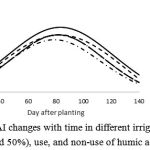 |
Figure 1: LAI changes with time in different irrigation levels (100%, 75% and 50%), use, and non-use of humic acid (H1 and H0) |
Dry matter accumulation from greening was logistic and increasing. For all treatment, dry matter accumulation process was slow at first and then rose exponentially, in the mid-season growth was linear, and slowed at the end of the growing season. At the end of the growing season, falling leaves and remobilization of assimilates to grain reduce dry matter accumulation process. Similarly, Garofalo and Rinaldi (2015) stated that the reduction in dry matter accumulation at the end of the growing season is due to negative net photosynthesis. In this study, the highest total dry matter (1550 grams per square meter) is related to treatment of 100% irrigation and application of humic acid, and the lowest (880 grams per square meter) is related to 50% irrigation and non-use of humic acid. In this study, the reason of higher dry matter in the treatment was no water stress, LAI, and subsequently gettimh the most solar radiation. Similarly, Seyed Sharifi and Rai (2011) reported that higher LAI increases the absorption of solar energy and biomass production. Drought has harmful and destructive effects on different stages of plant growth (Yukon et al., 2007). It seems that, with increasing drought stress receiving solar radiation of plant reduces, which is due to leaves wilt, restrictions in the growth, and development of leaves under water stress or premature aging of leaves (Nagugi et al., 2013). Vieira et al. (1991) stated the main reason of reduction in dry weight in water stress is due to reduction in photosynthesis. Humic acid consumption at all irrigation levels was better than non-use. Similarly, Parvazi Shandy, et al. (2013) studied the effect of irrigation period, growth promoting bacteria, and humic acid on yield and yield components of wheat of desert species. Their results showed that in irrigation levels, biological function at application of humic acid was better than control. On the other hand, in intense drought stress conditions based on 160 mm evaporation from evaporation pan class A, the use of humic acid significantly increased the biological yield of wheat. Ahmad and Jabin (2009) reported that the use of organic fertilizers increased plant height, stem diameter, and biological yield of sunflower. Results showed that humic acid significantly increases shoot, root, and dry weight of wheat (Sabzevari and Khazayi, 2009). This increase is due to improved soil structure and increase in water holding capacity of the soil, proper drainage, and good ventilation that extend root growth and nutrient uptake (Saleh, 2003).
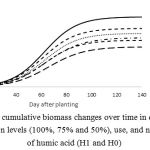 |
Figure 2: cumulative biomass changes over time in different irrigation levels (100%, 75% and 50%), use, and non-use of humic acid (H1 and H0) |
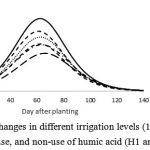 |
Figure 3: CGR changes in different irrigation levels (100%, 75% and 50%), use, and non-use of humic acid (H1 and H0) |
Net Assimilation Rate (NAR)
In all treatments, NAR trend until about 55 days after planting was increasing and since then declined. LAI is a contributing factor to NAR, so that by increase in LAI during the growing season, more leaves are completely or partially are under shadow and this decrease NAR. It seems that in the early stages of growth, due to limited leave area and the least competition between shrub and canopy, maximum net assimilation rate was observed that with the passage of time and increase the rate of absorption of shading to 55 days after planting net decreased to a steeper slope. In this study, maximum NAR was obtained from full irrigation and application of humic acid (4.8 grams per square meter per day) and its lowest level was in irrigation treatments 50% and non-application of humic acid (4.84 grams per square meter per day). Apparently, net assimilation and decomposition is influenced by many factors, whose measuring is actually complex and is not easily recognizable, and for this reason, the results of many researchers on the absorption of net decomposition are different from each other. For example, Tarig Aleslami et al. (2012) reported that the highest NAR was obtained in water stress in maize. They reported that the highest net assimilation rate was obtained from decomposition of 75 kg N ha and between different levels of nitrogen, and there was no significant difference in net assimilation process.
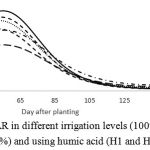 |
Figure 4: NAR in different irrigation levels (100%, 75% and 50%) and using humic acid (H1 and H0) |
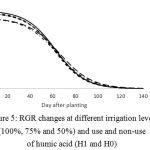 |
Figure 5: RGR changes at different irrigation levels (100%, 75% and 50%) and use and non-use of humic acid (H1 and H0) |
Relative Growth Rate (RGR)
RGR reduces with plant age, because the parts added to the plant are structural tissues that are not metabolically active and have no role in photosynthesis. Moreover, due to leaves getting into shade and increasing age, photosynthetic activity reduces and RGR decreases as well. Although the quantity of plant dry matter weight increases with time, RGR reduces due to increasing construction tissues to growing tissue. The results showed that in humic acid consumption treatment with increasing drought stress, RGR reached 0.074 g per day for irrigation levels of 50% and 75% from 0.076 g per day for irrigation 100%. Similarly, in the treatment of non-use of humic acid, RGR in full irrigation level was 0.075 and in 75% and 50% water stress, RGR did not differ and was 0.069. In humic acid use treatment with water stress, RGR decreased as 0.002 g per day, while in non-use of humic acid, that number reached 0.006 g per day. This indicates the greater sensitivity of RGR to drought stress in non-use of humic acid, so humic acid makes adjustment in drought. Moreover, as drought stress gets more severe, RGR decline increases, where the fastest decline in RGR is related to irrigation treatment with 50% and the lowest is in 100% irrigation. Similarly, Tarig Aleslami et al. (2012) studied the effects of different water stress on corn physiological parameters. They reported that the highest RGR decrease was in irrigation after 200 mm evaporation and the lowest was related to irrigation after 50 mm. Sajedi and Ardakani (2008) also found similar results.
Conclusion
The results show that drought stress is a limiting factor in LAI and receiving radiant energy, and these two factors limit production of dry matter, CGR, RGR, and NAR. Moreover, hhumic acid consumption due to its nutritional properties improved all indicators. On the other hand, in non-stress treatments (100% irrigation), using humic acid, compared to non-use, increased RGR, CGR, NAR and LAI, respectively, 1.3%, 21%, 8% and 12.5%. This is while in water stress (50% irrigation) and humic acid consumption, these indices increased 7%, 25%, 14% and 30% respectively representing a reduction in drought stress in humic acid use.
In general, it could be argued that the use of humic acid, due to adjusting the drought, could have a positive role in water stress to reduce the use of chemical fertilizers, reducing environmental pollution, and to mitigate drought stress, and as is suggested a stable source of supplying nutrients in drought conditions for maize.
References
- Parvazi Shandi, S1, Pazoki, *A.2, Asgharzadeh, A3. Azadi, A4 (2013). The effect of irrigation, growth promoting bacteria and humic acid on yield and yield components of wheat Desert, Knowledge of modern sustainable agriculture – Volume IX, Issue III, pages 1 to 8
- Tarigh Aleslami, M1* Zarghami, R2, Mashhadi Akbar Bujar, M3, Ovissi, M1. (2012) Effect of drought stress and nitrogen Mqadyrkvd on physiological indices of maize. Journal of Agriculture and Crop 8 (1): 160-174.
- Ahmad R, Jabeen N (2009) Demonstration of growth improvement in sunflower (Hellianthus annuus ) by the use of organic fertilizers under saline conditions. Pakistan Journal of Botany 41(3): 1373-1384.
- Saleh AL, Abd El-Kader AA, Hegab SAM (2003) Response of onion to organic fertilizer under irrigation with saline Egypt Journal of Appllied Science 18(12 B): 707-716.
- Sajedi, N. and Ardekani, A. 2008. Effect of nitrogen fertilizer, iron on the physiological indices forage maize in central provinces. Iranian Studies Journal of Agronomy 6 (1): 99-110.
- Sabzevari S, Khaziee HR (2009) The Effect of foliar application with humic acid on growth, yield and yield components of wheat (Triticum aestivum L.). Journal of Agroecology 1(2): 53-63.
- Mehdi Mahbod, M., Zand-Parsa, S., and Sepaskhah, A. 2014. Adjustment of radiation use efficiency of winter wheat by air temperature at different irrigation regimes and nitrogen rates. Archives of Agronomy and Soil Science. 60(1): 49-66.
- Wajid, A., Hussain, K., Maqsood, M., Ahmad A. and Hussain, A. 2007. Influence of Drought on Water Use Efficiency in Wheat in Semi-arid lRegions of Punjab. Soil and Environment, 26: 64-68.
- Zhang, X. and Ervin, E. H. 2004. Cytokinin-Containing Seaweed and Humic Acid Extracts Associated with Creeping Bentgrass Leaf Cytokinins and Drought Resistance. Crop Science, 44, 1737–1745.
- Ayas, H. and Gulser, F. 2005. The effect of sulfur and humic acid on yield components and macronutrient contents of spinach. Journal of biological sciences 5 (6): 801- 804.
- Seyed Sharidi R, Raei Y. 2011. Evaluation of yield and the some of physiological indices of barley (Hordeum vulgare L.) genotypes in relation to different plant population levels. Australian Journal of Basic and Applied Sciences 5(9): 578-584.
- Garofaloa, , & Rinaldi, M. 2015. Leaf gas exchange and radiation use efficiency of sunflower (Helianthus annuus L.) in response to different deficit irrigation strategies: From solar radiation to plant growth analysis. European Journal of Agronomy, 64: 88–97.
- Ngugi, K., Collins, J.O., and Muchira, S. 2013. Combining, earliness, short anthesis to silking interval and yield based selection indices under intermittent water stress to select for drought tolerant maize. Australian Journal of Crop Science, 7: 2014–2020.
- Ucan, K., Killi, F., Gencoglan, C., and Merdun, H. 2007. Effect of irrigation frequency and amount on water use efficiency and yield of sesame (Sesame indicum ) under field conditions. Field Crops Research, 101: 249-258.
- Viera, H. J., Bergamaschi, H., Angelocci, L. R. and Libardi, P. L. (1991) Performance of two bean cultivars under two water availability regimes. Pesquisa Agropecuaria 9:1035–1045.
- Mohamad Hesam Shahrajabian1*, Xuzhang Xue2, Ali Soleymani3, Peter Oko Ogbaji1, Yuegao Hu1. Evaluation of physiological indices of winter wheat under different irrigation treatments using weighing lysimeter. International Journal of Farming and Allied Sciences. 2 (24): 1192-1197.







